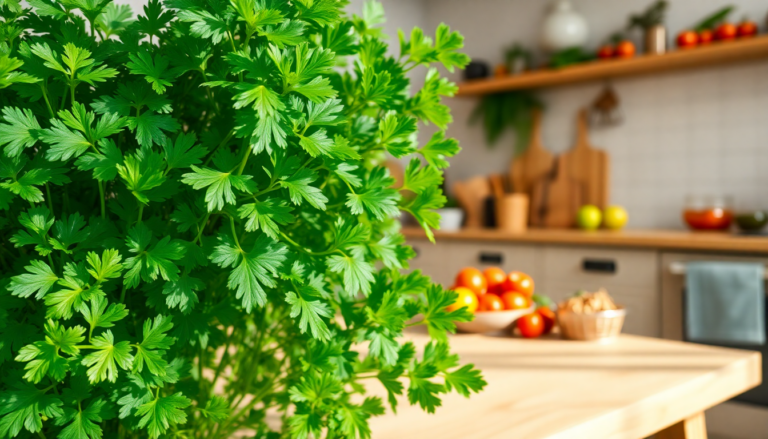Argomenti trattati
Imagine walking into your kitchen and snipping off fresh cilantro for your tacos or salads—sounds delightful, right? Growing cilantro at home is not just rewarding; it’s also a fantastic way to elevate your culinary skills. This herb, known for its unique flavor, can be a delightful addition to your dishes, and the best part? It’s surprisingly easy to grow. Whether you have a backyard or a sunny windowsill, getting started with cilantro can bring a taste of freshness to your meals.
Understanding cilantro and its dual benefits
Cilantro, also known as coriander, is a versatile herb that can do wonders in the kitchen. You might be aware that the leaves are used in a variety of dishes, but did you know that the seeds can be harvested to create coriander spice? It’s like getting two herbs for the price of one! According to Adam Weiss, a Master Gardener, this plant is perfect for beginners and can flourish in both garden beds and containers. I remember my first attempt at growing cilantro. I was amazed at how quickly it sprouted—within weeks, I had a lush batch ready for harvesting.
Choosing the right location for cilantro
Finding the perfect spot for your cilantro is crucial. This herb loves sunlight, so aim for a location that gets at least six hours of direct sunlight each day. If you’re growing indoors, a south-facing windowsill is ideal. However, in hotter climates, cilantro can benefit from a bit of afternoon shade to prevent it from bolting—when the plant flowers and the leaves turn bitter. Think of it this way: just like we need our beauty sleep, cilantro needs a comfortable environment to thrive!
Getting started: planting cilantro seeds
When it comes to planting cilantro, starting from seeds is often the best route. Adam suggests spacing the seeds about three inches apart and planting them half an inch deep. If you’re using a container, you can sprinkle 15 seeds like salt over the soil. Water them thoroughly and watch the magic happen! It’s fascinating to see those little sprouts emerge. The germination process usually takes about nine to twelve days, so patience is key. Trust me, it’s worth the wait.
Soil and watering: the essentials for healthy growth
Quality soil is a game changer for your cilantro. A rich, well-draining potting mix will do wonders, especially if you’re growing indoors. Gardening soil can work outdoors but may not retain moisture as well. A good tip? Add compost to enrich the soil with nutrients. Watering is another crucial aspect—allow the soil to dry out completely before watering again. I often use the finger test: if my finger comes out dry after checking the soil, it’s time to give it a drink. Aim for a watering schedule of about once a week, adjusting based on the weather. If the leaves start looking crispy, it’s a telltale sign they’re thirsty.
Harvesting cilantro: when and how
Once your cilantro reaches about six inches tall, it’s ready for its first harvest. Many gardeners, including myself, prefer to harvest the entire plant at once rather than trimming it back. This is partly due to cilantro’s short lifespan; it can bolt quickly in hot weather. Don’t be shy—snip away! Just remember to wash the leaves thoroughly before using them. If you store your freshly harvested cilantro in the fridge, it can last for a couple of weeks, but I doubt it’ll stick around that long if you’re cooking!
Dealing with pests and maintaining health
Cilantro is relatively pest-resistant, but it can attract aphids and cabbage loopers. Keep an eye out for these little critters, and don’t hesitate to use neem oil or your preferred pest control methods if needed. Maintaining humidity and warmth is essential for cilantro’s happiness. Yet, be cautious—temperatures above 80 degrees Fahrenheit can stress the plant and lead to bitterness in the leaves. It’s a delicate balance, but once you master it, you’ll have a thriving cilantro plant that brings joy to your kitchen.
Saving coriander seeds for next season
As your cilantro plant matures, keep an eye on its lifecycle. Once it flowers and the leaves start turning bitter, it’s time to think about harvesting those coriander seeds. Allow the plant to completely brown out, then gently shake the top over a bowl to catch the seeds. Store them in a cool, dark place, and you can use them for cooking or save them for next season. It’s like having a little treasure chest of flavor right in your pantry!
Indoor vs. outdoor cilantro: what to choose?
Growing cilantro indoors offers some advantages, like controlling pests and ensuring consistent moisture. However, the plant may not grow as large or robust as it would outdoors. I’ve found that growing cilantro on my countertop is perfect for snipping off a few leaves at a time for recipes. Just remember, once it flowers, the leaves lose their flavor. So, if you’re serious about harvesting, outdoor gardening might be the way to go, especially during cooler months.
Ultimately, whether you choose to grow cilantro indoors or outdoors, the key is to enjoy the process. Gardening can be a therapeutic escape from our busy lives, and the satisfaction of using your home-grown herbs in your meals is unrivaled. So roll up your sleeves, get your hands dirty, and embark on this flavorful journey!

